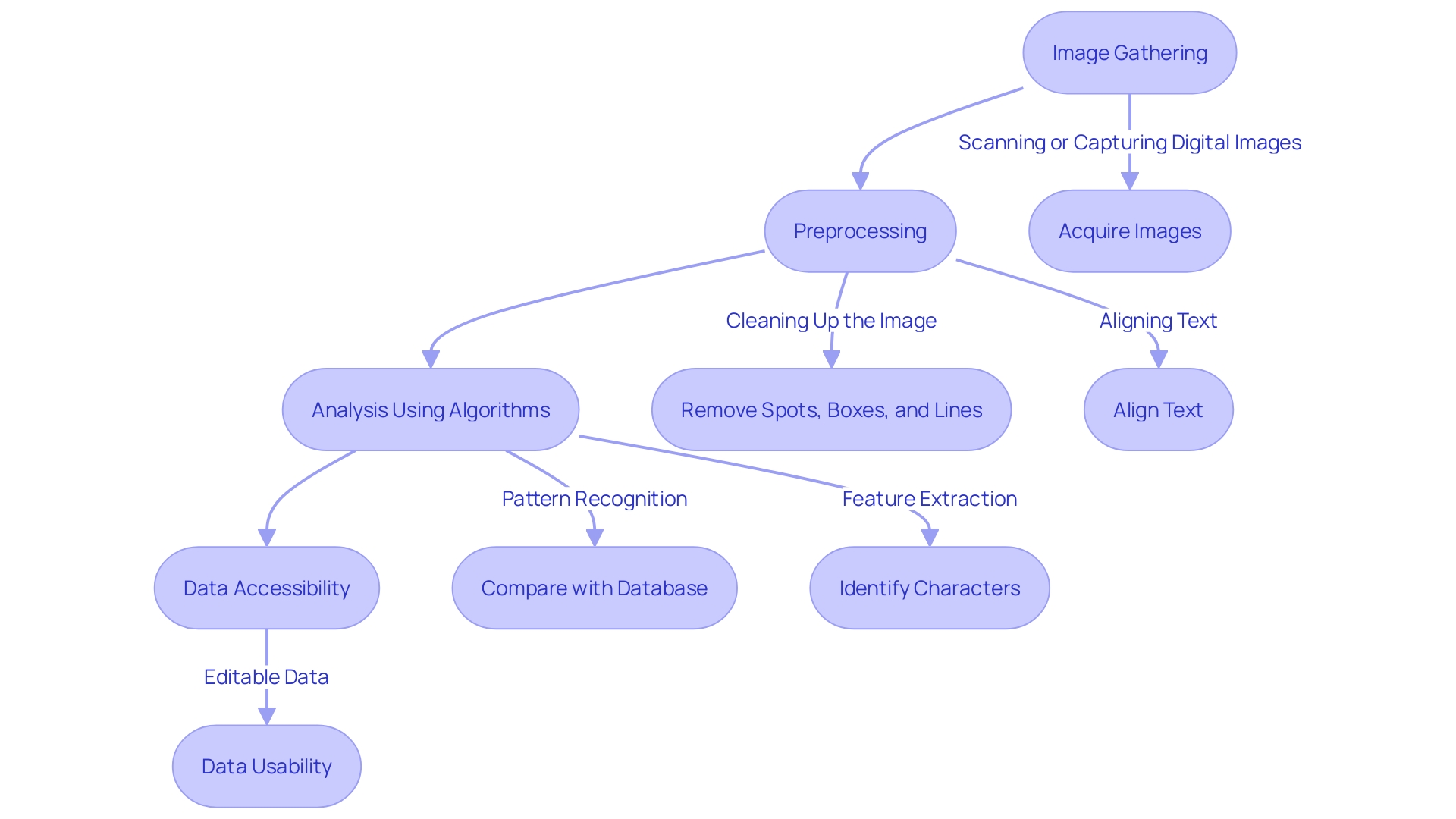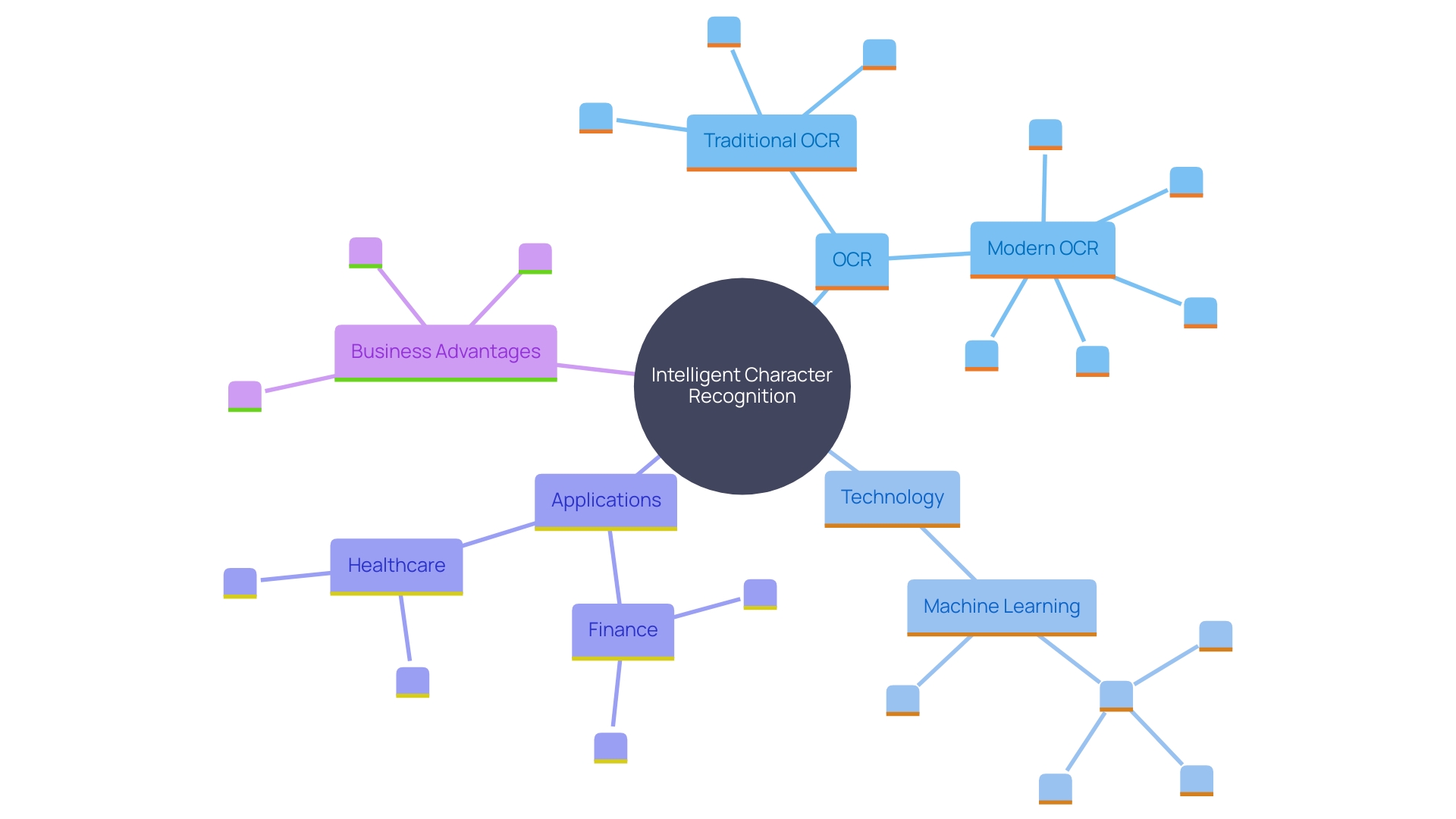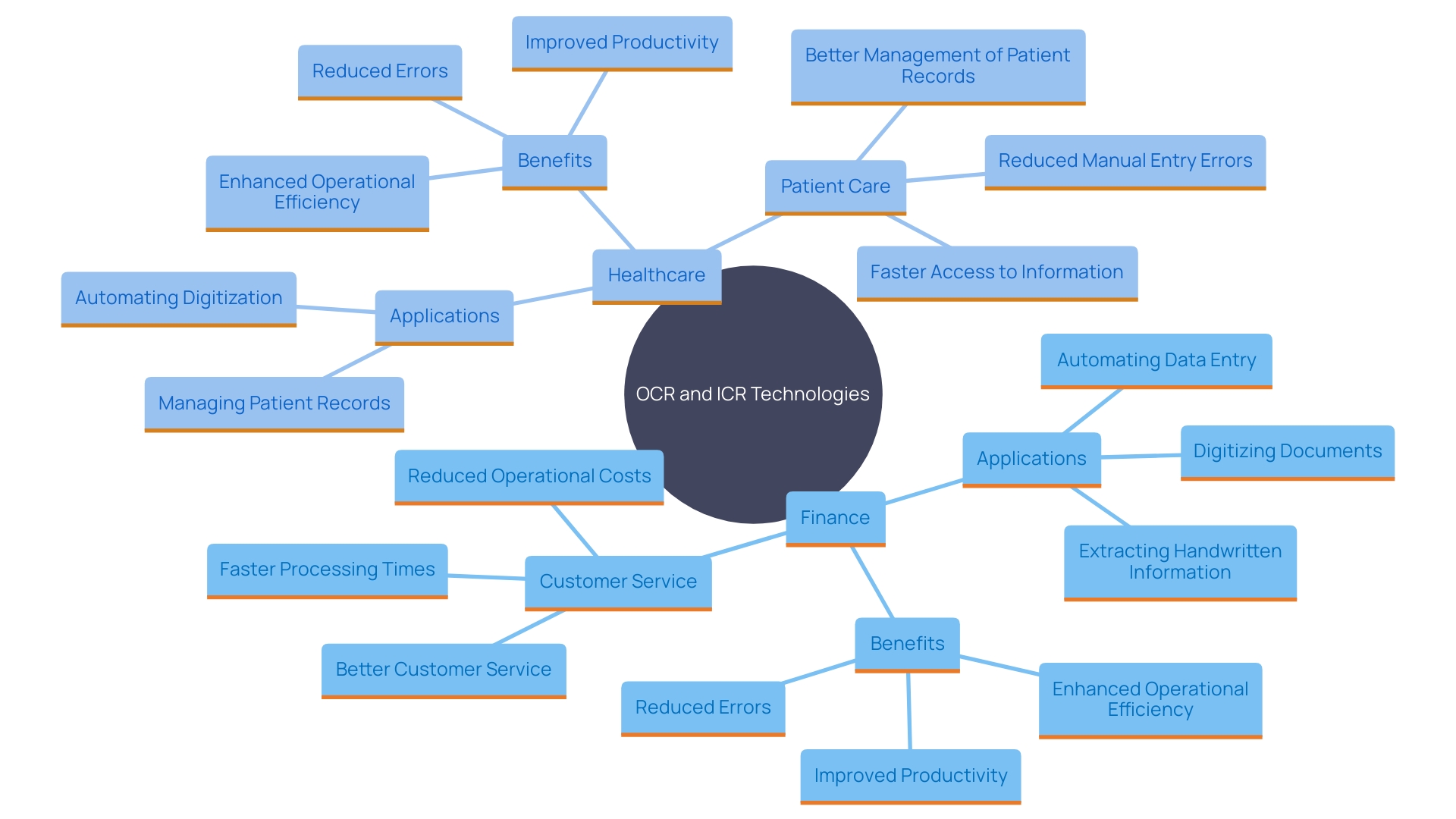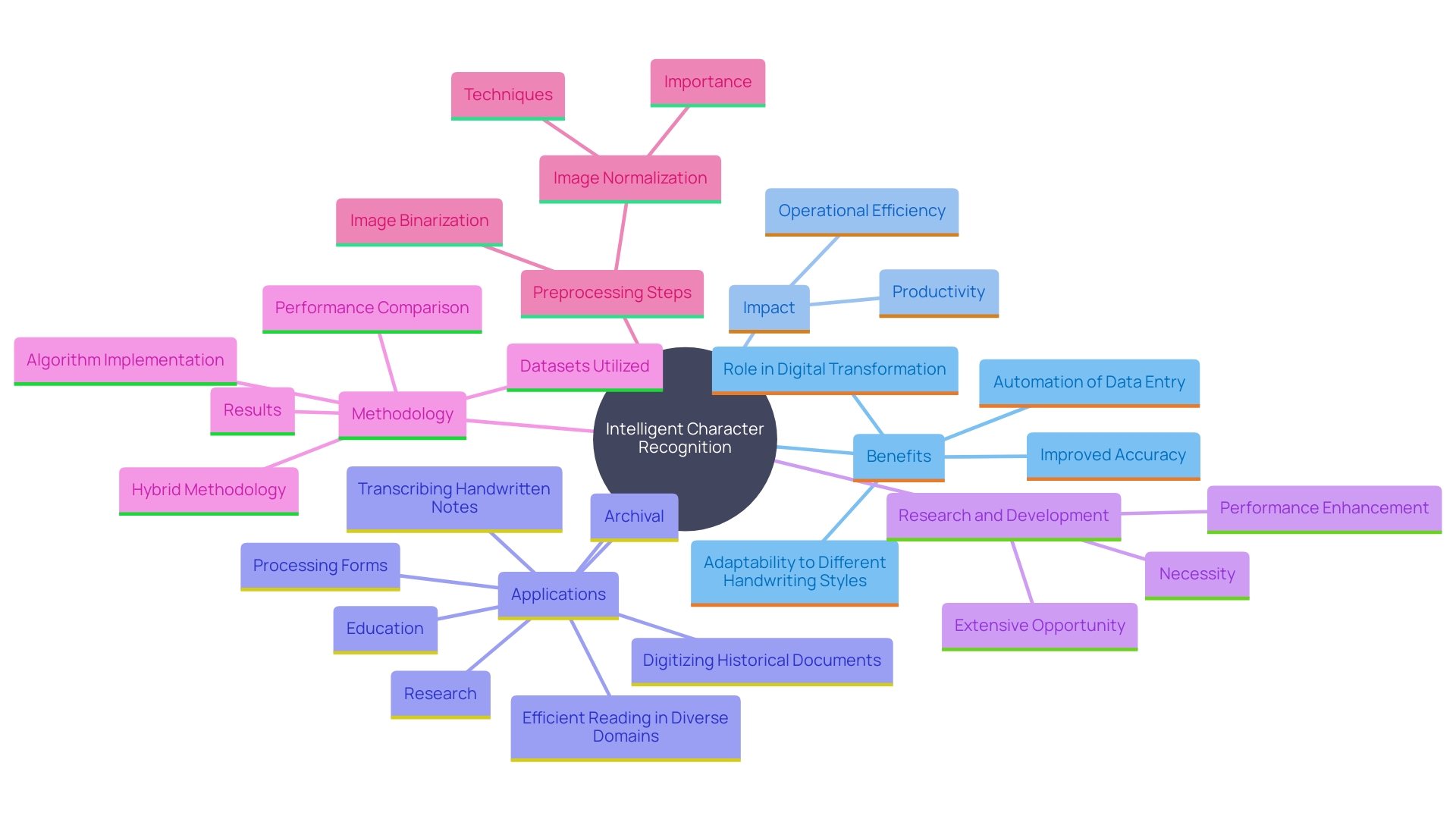Introduction
Optical Character Recognition (OCR) and Intelligent Character Recognition (ICR) technologies are revolutionizing the way organizations handle text and data. OCR transforms printed and handwritten text from documents, images, and videos into digitally editable and searchable data, significantly reducing manual data entry and enhancing data accessibility. This technology is vital in modern document management, offering solutions such as reading product identifiers on assembly lines and digitizing entire books.
ICR takes this a step further by focusing on handwritten or cursive text, leveraging machine learning models to adapt to different handwriting styles, thus enhancing accuracy. This advancement opens up broader applications, especially in sectors like finance and healthcare, where automated data capture is crucial. The integration of ICR with natural language processing and machine learning by leading companies further boosts its performance and versatility, providing substantial business advantages.
The distinctions between OCR and ICR highlight their respective strengths: OCR excels in recognizing printed text, making it ideal for digitizing books and documents, while ICR is tailored for handwritten text, improving its accuracy over time with advanced machine learning techniques. These technologies streamline data entry and retrieval processes, transforming operations to meet modern demands for speed, precision, and security. As industries continue to adopt OCR and ICR, the benefits of enhanced productivity, reduced errors, and improved operational efficiency become increasingly evident.
What is Optical Character Recognition (OCR)?
Optical Character Recognition (OCR) is a transformative technology that converts both handwritten and typed content from various sources, such as scanned documents, PDFs, images, and videos, into digitally editable and searchable data. The process starts with image gathering, where a scanner captures the content and converts it into a black-and-white image. This image undergoes preprocessing to enhance its quality by removing digital noise, aligning characters, and improving contrast.
Next, the OCR software analyzes the preprocessed image using advanced algorithms like pattern recognition and feature extraction. Pattern recognition compares visual representations character by character against a database of known characters, while feature extraction focuses on identifying key features of the characters. Optical Word Recognition, a variation of OCR, identifies whole words instead of individual characters, which is particularly useful for stylized writing.
OCR methods are widely employed in diverse applications, ranging from reading product identifiers on assembly lines to digitizing entire books. It significantly reduces manual data entry and enhances data accessibility, making it a vital component in modern document management and productivity enhancement. The system’s adaptability includes identifying logos, watermarks, and symbols using Optical Mark Recognition and converting handwritten characters with Intelligent Character Recognition, which utilizes machine learning to enhance precision gradually.
By automating these processes, OCR streamlines data entry and retrieval, allowing organizations to focus on more strategic tasks. This not only boosts operational efficiency but also ensures that critical information is readily accessible and actionable.

What is Intelligent Character Recognition (ICR)?
Intelligent Character Recognition (ICR) enhances traditional OCR by focusing on the identification of handwritten or cursive writing. Unlike OCR, which excels in interpreting printed characters, ICR leverages advanced machine learning models to adapt to different handwriting styles, significantly enhancing accuracy. This capability opens up broader applications for automated data capture, making it particularly valuable in sectors like finance and healthcare. For example, at Gusto, the integration of OCR technology has streamlined data extraction processes, enabling efficient and precise service delivery. Similarly, the advancements in natural language processing and machine learning by companies like Intel and Red Hat further bolster the performance and versatility of ICR, providing enterprises with substantial business advantages.

How ICR Differs from OCR
The primary distinction between Intelligent Character Recognition (ICR) and Optical Character Recognition (OCR) lies in their respective functionalities. OCR is skilled at identifying printed characters, making it ideal for digitizing books and documents with uniform fonts. In contrast, ICR is specifically designed for handwritten text, leveraging machine learning techniques to adapt and improve its accuracy over time. This capability allows ICR to handle a diverse range of handwriting styles and formats, which is particularly beneficial in processing forms and surveys.
ICR’s adaptability is a game-changer in environments where data entry involves varying handwriting levels. For instance, in the healthcare sector, the digitization of handwritten patient records has historically been time-consuming and prone to errors. ‘The integration of ICR methods has streamlined this process, significantly reducing manual input and enhancing accuracy.’. Similarly, financial institutions benefit from ICR through faster processing times and reduced operational costs, as the technology automates the recognition and digitization of handwritten documents.
Moreover, contemporary OCR systems incorporate deep learning methodologies such as Convolutional Neural Networks (CNNs) and Long Short-Term Memory (LSTM) networks, which improve recognition capabilities. These advancements have established a new benchmark in OCR precision, making it a robust solution for recognizing printed characters in diverse applications. Meanwhile, ICR continues to evolve, leveraging these machine learning techniques to enhance its efficiency and accuracy, thus providing a comprehensive solution for handwritten character recognition.
Applications of OCR and ICR
OCR and ICR methods are essential across various sectors because of their capacity to optimize workflows and improve productivity. OCR is pivotal in digitizing printed documents, automating office data entry, and making text searchable in archives. For example, in financial institutions, OCR systems automate the digitization of voluminous paperwork such as invoices, checks, and loan documents, significantly reducing processing times and operational costs. This automation not only improves customer service but also enhances fraud detection and loan processing accuracy.
ICR, conversely, excels in extracting handwritten information from documents like forms, invoices, and surveys. This capability is particularly transformative in sectors like healthcare, where managing patient records, including handwritten notes and prescriptions, has traditionally been labor-intensive and error-prone. ‘The introduction of cloud-based ICR solutions has automated the digitization of these records, enabling seamless integration into electronic health systems and reducing manual entry errors.’.
In practical uses, firms managing large amounts of documentation gain significant advantages from these tools. Consider a company with 20 employees generating 84 tax-related documents annually. The manual processing of these documents is not only time-consuming but also prone to errors. By leveraging OCR and ICR, these companies can automate data extraction and processing, ensuring accuracy and efficiency.
‘These innovations are not just about reducing manual tasks; they are about transforming operations to meet modern demands for speed, precision, and security.’. As industries continue to adopt OCR and ICR, the benefits are clear: enhanced productivity, reduced errors, and improved operational efficiency.

Benefits of Using ICR
Applying Intelligent Character Recognition (ICR) systems can transform data management procedures within organizations. By automating the recognition of handwritten characters, ICR significantly reduces the time and expenses related to manual data entry. This advanced form of OCR leverages machine learning techniques to enhance accuracy over time, minimizing the risk of errors common with human input. According to a report by Gusto, automating document processing has allowed them to maintain high accuracy and serve customers efficiently.
Moreover, ICR’s capacity to process various handwriting styles enables businesses to streamline customer interactions and documentation, leading to improved operational effectiveness. The integration of ICR in Intelligent Document Processing (IDP) systems provides a cutting-edge solution to the traditionally labor-intensive and error-prone task of manual data entry. As noted by Indico Data, the adaptability and scalability of these systems are expected to drive digital transformation, enhancing productivity across various sectors.
By converting unstructured data into machine-readable text, ICR bridges the gap between physical documents and digital systems, allowing for more efficient data extraction and management. As the volume of business documents continues to grow exponentially, the implementation of ICR technology becomes increasingly indispensable for maintaining operational efficiency and accuracy.

Conclusion
The advancements in Optical Character Recognition (OCR) and Intelligent Character Recognition (ICR) technologies are reshaping the landscape of data management across various industries. By automating the conversion of printed and handwritten text into digitally editable formats, these technologies streamline workflows and significantly reduce the time and costs associated with manual data entry. This not only enhances productivity but also ensures that critical information is readily accessible and actionable.
OCR excels in digitizing printed documents, making it an invaluable tool for sectors that rely on processing large volumes of paperwork, such as finance and healthcare. The ability to automate tasks such as invoice processing and loan documentation leads to increased operational efficiency and improved accuracy. Meanwhile, ICR takes this a step further by effectively handling diverse handwriting styles, thus addressing the challenges associated with traditional data entry methods.
Its application in sectors like healthcare demonstrates its potential to transform labor-intensive processes into seamless, efficient operations.
The integration of machine learning techniques into both OCR and ICR continues to enhance their capabilities, ensuring that organizations can keep pace with the growing demands for speed, precision, and security. As these technologies evolve, their role in fostering digital transformation becomes clear. Embracing OCR and ICR not only mitigates errors but also empowers organizations to leverage their data more effectively, paving the way for improved decision-making and operational success.

